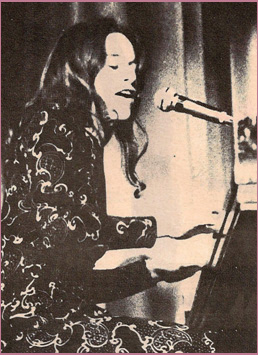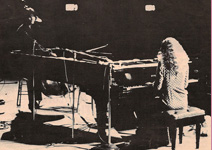From 1961 to 1964, she cranked out hits like "WiII You Love Me Tomorrow?," "Go Away Little Girl," The Animals' "Don't Bring Me Down," Bobby Vee's "Take Good Care Of My Baby," "Chains," "Don't Say Nothing Bad About My Baby," "One Fine Day," "The Locomotion," and the West Side Story of "On The Roof," to name but a few.
But the limitations of the AM sound took their toIl on Carole in 1964, when the Beatles came on the scene. "It was difficult to adjust," remembers Carole, "because these groups provided their own material. I never wanted to be an artist, but after awhile it becarne the most efficient way of getting songs to people."
Solo debut: By 1968, Carole was ready to give it a go as a recording artist. She had had sorne mild success with “It Might As WelI Rain Until Septernber," her own composition, and had split from her husband, Gerry Goffin. She left for Los Angeles to join musician-friends Danny (Kootch) Kortchmar, Charles Larkey (now her husband) and Jim Gordon to form a group called The City, but the timing was evidently wrong for a folk oriented group. The City LP, produced byAdler, was never released and today remains a collectors item. The groupitself languished and split in different directions: the musicians added some more friends and became Jo
Mama; and Carole became a solo artist.

|
|
Her first solo LP, Writer, was an over-produced, experimental solo ef fort ; yet behind the heavily supplied orchestration, Carole's hauntíng Iyrics shone through. "She was discouraged after Writer," says Adler. "She never showed it, but she was." The LP sold only about 6,000 copies at the time, and one year later Carole returned to the studio to make a masterpiece of an album that would crystallize her solo status as the top female performer in the world.
Tapestry surprised both producer Adler and Carole, fulfilling their wildest hopes. "When an album seIls as much as Tapestry" says Lou, "you really don't know what did it. It's hard to figure out when they sell that much." Tapestry, claims Adler, came close to being the best selling album in history. "It was a totalIy different album," he says. "For one, it was underproduced,and that's what was necessary with her." The constant themes of Tapestry underlined friendship, loneliness and the sorrow of relationships gone sour in haunting numbers like "You've Got A Friend," and "So Far Away." These would prove repetitive themes in her third solo LP, Music, which Adler cIaims is not an extension of Tapestry." The album in retrospect was sornething you got out after you had a big album. The group just got off on playing." Unlike Rhymes and Reasons, Adler believes Music's long instrumentals took away from Carole's voice. "If you turned on the radio, you wouldn't have recognized Music's instrumentals as being from a Carole King album. With Rhymes and Reasons, you always know it's a King record."
She makes RHYMES click: Carole King, at work, is a total musician. During the recording of Rhymes and Reasons, Adler explained, "She was the best. She's fast and she doesn't waste time. Her albums take three to four weeks. On this new LP, she came in with about eighteen songs and we went over them and decided which to record." This kind of total preparedness, makes Carole both a captivating vocal personality and a true professional. "You never question her honesty, she never lets you down," says Adler. "She has that way of saying things that a lot of other people want to say."
On Rhymes and Reasons as on Tapestry, she once again says what must
be said for the sorrowful and the lonely, sketching sentimental daydream pictures of friendships and lost loves that wilI capture the soul of each listener.Most of the cuts, co-written by Carole and Toni Stern (who wrote the lyrics for "It's Too Late") express that sense of personal loss, that melancholy for good times past:
|
|
So come down. easy
Let it come down slow
l've been alone so long
That I [ust don't know what to do
And I don't want to lose you
"Come Down Easy"
(Carole King and Toni Stern)
Yet others express the hopeful optimism of, better things to come, and a general optimistic hope for rnan:
But I think I saw a brand new light
Coming over the horizon
Brighter than all the others
And it says all men are brothers
under the skin ...
"Peace In The Valley"
(Carole King and Toni Stern)
A warm blanket to cuddle up with:
Rhymes and Reasons contains songs that you'lI whistle in the shower, hum in the park, and literally take to heart. It's clean sunshine music, vibrant airy sounds-like the blue of the sky and the fluffy lightness of the clouds. Some songs have the crisp feel of a brand new dollar bill. It's a warm blanket of sound. And Carole's happy with her latest LP. "She's really happy now," says Adler. "She got a new baby, and she's with a nice guy." Walking out of a local 'Hollywood bank near the A & M studios, a short, pug-nosed girl, dressed in a patch- worked granny dress and carrying a three month old baby, goes to the teller booth. The teller calls her by her first name, she makes her withdrawal, then turns to enter her Willies Jeep to return to her modest Laurel Canyon home. An anxious photographer recognízes Carole and rushes to capture her on film. She politely asks him not to take any photos. "Take a picture of the sky and the clouds," she whispers. "It'll do you good."

|